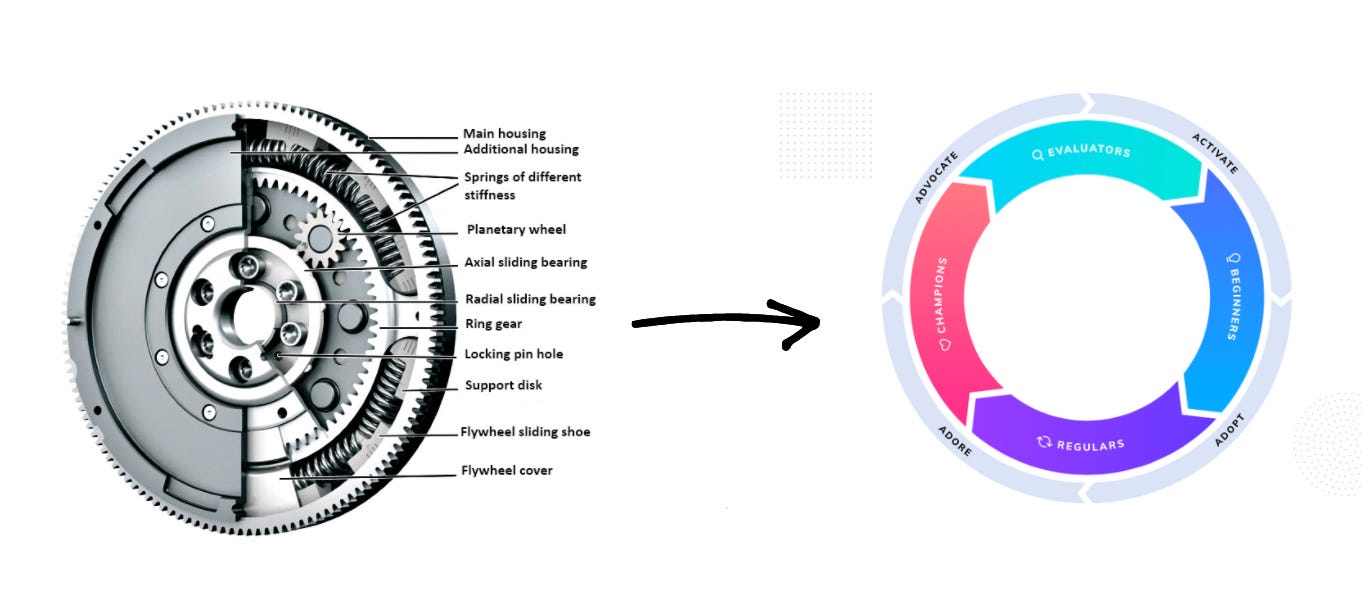The flywheel model is common for driving the growth of top companies such as HubSpot, Asana, Atlassian, and many more. However, many product managers have yet to grasp and use the flywheel model to drive business impact in their day-to-day work. If you are thinking of designing or leveraging the flywheel model for your organization, this article will give you a preliminary understanding of how it works and how you can go about applying it. This also helps you understand how your role fits into the bigger picture so you can best design your work to realize strategic impact.
The Flywheel Model
Invented by James Watt, the flywheel is simply a wheel that’s incredibly energy-efficient. The amount of energy it stores depends on how fast it spins, the amount of friction it encounters, and its size. — HubSpot
The diagram below compares the flywheel in the real world versus the flywheel model adapted in software businesses. Though the specific components making up the flywheels are different, a closer look into the mechanics and concepts reveals the following key forces:
how fast it spins: the speed at which your flywheel can attract more customers or purchases, such as network effect, word of mouth, referrals, etc.
the amount of friction: resistance faced by your users or customers that are preventing them from use or purchase, such as onboarding flows, ease of use, adoption to core features, etc.
size: dollar value captured as measured by the total number of users and units purchased. This is commonly influenced by the total addressable market (TAM), customer size (e.g. an organization with 10 employees versus 1000 employees), and pricing strategy, etc.
Land customers
The first step to kickstart your flywheel is to land customers through a great product that satisfy their needs. If you are hired as a product manager at the post-PMF stage, here are a few tips you can consider to get started on accelerating the flywheel:
Understand the market & customers
What's the total addressable market? What are the customer personas your product serves? How much are they spending that spins the flywheel? What are their needs and use cases? Are there hidden opportunities to increase their total spend?
Look into key metrics
Look into metrics that reveal signals of how the flywheel is performing, such as:
activation rate: did your onboarding work or need further improvements
churn rate: why your product is not growing as fast as you hope for
active users: cluster active users to identify opportunities to increase the size and speed of your flywheel (e.g. who are highly likely to be the champion of your product? who have a higher willingness or budget to spend?)
This allows you to start diagnosing what is not working well and come up with product improvements to drive growth.
Study a validated flywheel or design one for your product
Look into flywheel models of successful companies and learn from them, what have they done well that you can use in your product.
Expand
Expand is the act of widening your product offerings to satisfy other use cases of customers, thus increasing stickiness and customer spend. In an increasingly competitive market, it is not enough to have happy customers, and this is where product managers need to think about how to keep the flywheel going when planning ahead. The following will elaborate on the two most common strategies: upsell & cross-sell.
Upsell
Upsell is generally a sales terminology to persuade customers to spend more on a higher tier or premium product. A good analogy of this is unlocking new gears in your Super Mario game, thus allowing your customers to do more by spending more (coins), thus increases the size of flywheel. Some of the common tactics are as follows:
Build a strong ecosystem around your product, with key partnerships that strongly aligns with current customers.
Examples: Slack’s partner ecosystem, GitHub’s partner ecosystem
Offer a premium version of product or product features, with an option to upgrade.
Examples: Intercom’s premium tiers with advanced features, Confluence cloud premium
Cross-sell
Cross-sell is the act of selling additional, complementary products to your existing customers to increase spend. This is generally adopted when product teams find out that there are underserved use cases in their existing customers with a huge enough opportunity that requires a different product. The following diagram illustrates how it works:
existing customers are satisfied with product A
X% of existing customers have a need for product B which your organization offer
X% of existing customers discover that they can use product A with product B to unlock more value
customers realize the value of using product A with product B, which leads to adoption and purchase
This is a really powerful mechanism because there are two pathways in which your new product B can acquire new customers:
new customers coming from existing product (e.g. product A)
new customers coming to a new product
This requires product managers to work relentlessly to understand customers to deliver strong cross-product features that unlock the value of using product A and B together.
Conclusion
I hope this help you to think about how your work as a product manager can help drive the growth of business, so you can start choosing to work on what matters most.
Recommended Readings
https://tomtunguz.com/saas-innovators-solution/
https://www.hubspot.com/flywheel





